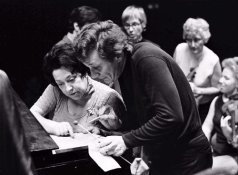- Joined
- Dec 31, 2006
- Messages
- 2,704
- Format
- Medium Format
Hi John,
I do believe, though, that the build up of a level of bromide is what's having a good effect on the results of the film processing. After the developer was seasoned, I saw nicer gradations in the highlights especially, more beautiful modulation right at the top end of the brightness range.
*****
That is good for me to know what is happening. I remember the old lab rats saying that it takes a while for the "76" to "start gettin' gud." I guess that is the reason why Gene Smith and others would add a bit of used developer to the fresh one shot.
Since I generally just shoot "normal" contrast, straight D23 works for me. In those exteme contrast scenes, I just let things fall as they may and try to print the highlights down. I am not always successful. I read years ago where someone wrote about the genius of D23 when dealing with a roll of film containing "morse code" images--I think that was the term--some negs on the roll with lots of contrast, others kind of flat; but that because of the "semi-compensating" effect of D23, printable negs were easier to obtain with D23 than with any other film developer. I have found this to be the case.
Some of my better negs make prints which seem to have an almost three-dimensional effect whereby one feels as if it is not a flat surface one is viewing. It seems as if one can "reach around" behind the image on the paper. I surmize this is because of the good mid-tone separation. I do not know.
I know I am kind of set on D23 and refer to it ad nauseum, but I wish I had know about it in my early days. It just simplifies my printing so much.
I do believe, though, that the build up of a level of bromide is what's having a good effect on the results of the film processing. After the developer was seasoned, I saw nicer gradations in the highlights especially, more beautiful modulation right at the top end of the brightness range.
*****
That is good for me to know what is happening. I remember the old lab rats saying that it takes a while for the "76" to "start gettin' gud." I guess that is the reason why Gene Smith and others would add a bit of used developer to the fresh one shot.
Since I generally just shoot "normal" contrast, straight D23 works for me. In those exteme contrast scenes, I just let things fall as they may and try to print the highlights down. I am not always successful. I read years ago where someone wrote about the genius of D23 when dealing with a roll of film containing "morse code" images--I think that was the term--some negs on the roll with lots of contrast, others kind of flat; but that because of the "semi-compensating" effect of D23, printable negs were easier to obtain with D23 than with any other film developer. I have found this to be the case.
Some of my better negs make prints which seem to have an almost three-dimensional effect whereby one feels as if it is not a flat surface one is viewing. It seems as if one can "reach around" behind the image on the paper. I surmize this is because of the good mid-tone separation. I do not know.
I know I am kind of set on D23 and refer to it ad nauseum, but I wish I had know about it in my early days. It just simplifies my printing so much.



